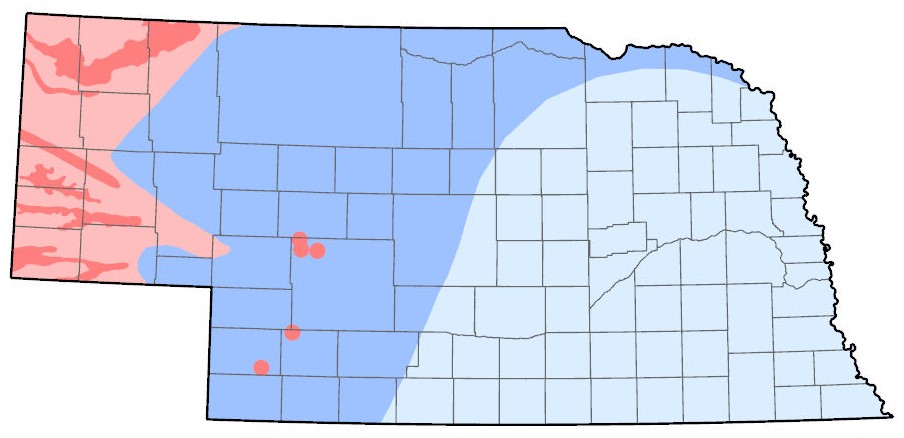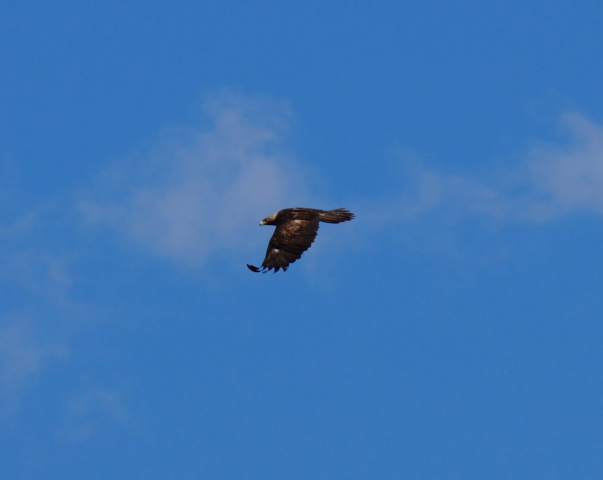Aquila chrysaetos canadensis
Status: Uncommon regular spring and fall migrant west and central. Uncommon regular resident west. Uncommon regular winter visitor west, central, and northeast, rare southeast.
Documentation: Specimen: UNSM ZM12988, 8 Nov 1912 Comstock, Custer Co.
Taxonomy: There are six subspecies recognized, five in Eurasia and one, canadensis, in North America and far northeast Russia (AviList 2025).
Nebraska birds are canadensis.
Spring: winter<<<>>>May 19, 19, 20
Last dates above are from the east and east central; most are non-breeding immatures drifting westward from easterly wintering locations.
Migration begins with adults in early Feb, peaking late Mar-early Apr, and continues with sub-adults through mid-May (Wheeler 2003).
Summer: Bruner et al (1904) stated that “years ago” it bred “quite generally over the state,” but that by 1904 its range was limited to the Pine Ridge area. Ducey (1988) noted breeding reports from Douglas Co in 1884 and possibly in Nemaha Co in the 1880s.
Currently Golden Eagles breed throughout the Panhandle, west of the Sandhills. In 2007, 20+ nests were located in the Panhandle (Bart Bly, Silcock 2007). As late as the 1980s, Golden Eagles nested further east, in Chase, Keith, Garden, Lincoln, and Hayes Cos (Busch 1979; Bennett 1973, 1975, 1986; Rosche 1994; Brown and Brown 2001; NGPC unpublished data). A comparison of the spatial distribution of nesting records from the 1970s and 1980s with the 2000s (NGPC, unpublished data) suggests the breeding range has continued to erode in the Panhandle. However, Mollhoff (2016) reported recent confirmed nesting in south-central Garden County and eastern Cheyenne County. Suggestive of a resident pair and possible recent breeding in Keith Co were two adults there 11 Aug 2007 (Stephen J. Dinsmore, personal communication). Similarly, sightings near Nenzel, along the Niobrara River in northern Cherry Co, are suggestive of breeding; there were sightings there 13 Jun and a pair was present 22 Jun 2002, and, earlier, an adult was near Springview, Keya Paha Co 25 Jul 1999 and a single was in Thomas Co 17 Aug 2014. In 2022, near Spencer, Holt Co a pair of adults was present 24 and 25 Aug. One was near Valentine, Cherry Co 11 Aug 2024.
There are a few reports in summer from the Panhandle in areas where breeding sites are not known; these are likely non-breeding sub-adults: 2 Jun 1996 Box Butte Co, Jul 1973 Sheridan Co, 30 Jun 1967, 17 Jul 1996, 25 Jul 1977 Garden Co, 12 Aug 1983 in McPherson Co, and 13 Aug 1992 Morrill Co. A subadult was as far east as the Crookston area, Cherry Co 5 Jun 2024. Breeding may not occur until birds are 4-7 years old (Kochert et al 2020).
- Breeding Phenology:
Nest-building: 15 Mar
Eggs/Incubation: 13 Mar-30 May (Mollhoff 2022)
Nestlings: 23 Apr-21 Jun
Fledglings: 2 Jun-12 Jul
Fall: Sep 25, 25, 26 <<<>>> winter
Early dates above are away from the breeding range. There is a gradual drift eastward in fall, mostly of immatures, which may begin dispersing in late Aug (Wheeler 2003).
Earlier dates away from the breeding range are 2 Aug 2009 Valentine, Cherry Co, 11 Aug 2009 Lincoln Co, 11 Sep 2010 Valentine NWR, Cherry Co, 13 Sep 2007 Keith Co, 13 Sep 2019 Dawson Co, 16 Sep 1978 Garden Co, and 17 Sep 2018 Boyd Co.
Fall sightings in the east occur every year; the Hitchcock Nature Center Hawk Watch in western Pottawattamie Co, Iowa, averages 19 Golden Eagles per year, with a poorly defined peak from late Oct through Nov. Padelford and Padelford recorded Golden Eagles in the Missouri Valley 28 Sep-9 Nov in three of five years in the early 1990s.
Winter: Breeders are probably resident year-round (Rosche 1982; Palmer 1988; Kochert et al 2020), but individuals, mostly sub-adults, may appear anywhere in the state during the winter months. Numbers are fewest in the east, where there are about 78 reports in the period 6 Oct-30 Apr, fairly evenly spread throughout the winter period. The winter 2012-2013 saw a major move eastward, including a surprising four adults: Dodge Co 11 Dec, Otoe Co 18 Jan, Washington Co 3 Feb, and Butler Co 15 Mar. Even in westerly North Platte, the 3+ reported 2012-2013 constituted an “irruption” (T.J. Walker, personal communication). Two adults reached the east in 2014-2015, in Otoe Co 5 Dec and Lancaster Co 30 Jan. One was in Burt Co 1 Jan 2018, and in 2020-2021 one was Sarpy Co 28 Feb.
Midwinter Eagle and Waterfowl Surveys conducted by NGPC 1992-98 yielded statewide totals for Golden Eagles ranging from 15 in Jan 1992 to 35 in 1995 (Cortelyou 1992, 1993; Dinan 1995,1996); methodology of these counts may have allowed for inadvertent inclusion of young Bald Eagles.
Images
Abbreviations
NGPC: Nebraska Game and Parks Commission
NWR: National Wildlife Refuge
UNSM: University of Nebraska State Museum
Literature Cited
AviList Core Team, 2025. AviList: The Global Avian Checklist, v2025. https://doi.org/10.2173/avilist.v2025.
Bennett, E.V. 1973. 1972 Nebraska nesting survey. NBR 41: 3-9.
Bennett, E.V. 1975. 1974 Nebraska nesting survey. NBR 43: 13-19.
Bennett, E.V. 1986. 1985 Nebraska nesting survey. NBR 54: 31-35.
Brown, C.R., and M.B. Brown. 2001. Birds of the Cedar Point Biological Station. Occasional Papers of the Cedar Point Biological Station, No. 1.
Bruner, L., R.H. Wolcott, and M.H. Swenk. 1904. A preliminary review of the birds of Nebraska, with synopses. Klopp and Bartlett, Omaha, Nebraska, USA.
Busch, D.E. 1979. Successful Golden Eagle nest in southwest Nebraska. NBR 47: 57.
Cortelyou, R.G. 1992. Bald and Golden Eagle Sightings in Nebraska. NBR 60: 52-60.
Cortelyou, R.G. 1993. 1993 Midwinter Survey of Bald and Golden Eagles in Nebraska. NBR 61: 22-27.
Dinan, J. 1995. 1994 and 1995 Surveys of Bald and Golden Eagles in Nebraska. NBR 63: 23-27.
Dinan, J. 1996. 1996 Survey of Bald and Golden Eagles in Nebraska. NBR 64: 26-29.
Ducey, J.E. 1988. Nebraska birds, breeding status and distribution. Simmons-Boardman Books, Omaha, Nebraska, USA.
Kochert, M.N., K. Steenhof, C.L. McIntyre, and E.H. Craig. 2020. Golden Eagle (Aquila chrysaetos), version 1.0. In Birds of the World (S. M. Billerman, Editor). Cornell Lab of Ornithology, Ithaca, NY, USA. https://doi.org/10.2173/bow.goleag.01.
Mollhoff, W.J. 2016. The Second Nebraska Breeding Bird Atlas. Bull. Univ. Nebraska State Museum Vol 29. University of Nebraska State Museum, Lincoln, Nebraska, USA.
Mollhoff, W.J. 2022. Nest records of Nebraska birds. Nebraska Ornithologists’ Union Occasional Paper Number 9.
Palmer, R.S., ed. 1988. Handbook of North American birds. Vol. 4. Diurnal Raptors (Part 1). Yale University Press, New Haven, Connecticut, USA.
Rosche, R.C. 1982. Birds of northwestern Nebraska and southwestern South Dakota, an annotated checklist. Cottonwood Press, Crawford, Nebraska, USA.
Rosche, R.C. 1994. Birds of the Lake McConaughy area and the North Platte River valley, Nebraska. Published by the author, Chadron, Nebraska, USA.
Silcock, W.R. 2007. Summer Field Report, June-July 2007. NBR 75: 70-85.
Wheeler, B.K. 2003. Raptors of Western North America. Princeton University Press, Princeton, New Jersey, USA.
Recommended Citation
Silcock, W.R., and J.G. Jorgensen. 2025. Golden Eagle (Aquila chrysaetos). In Birds of Nebraska — Online. www.BirdsofNebraska.org
Birds of Nebraska – Online
Updated 13 Jul 2025, map updated 8 Mar 2023

